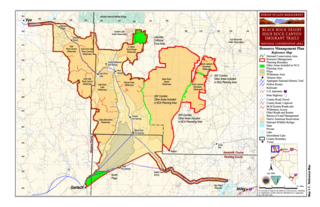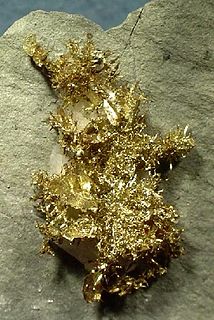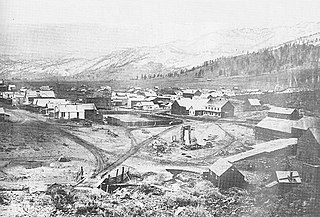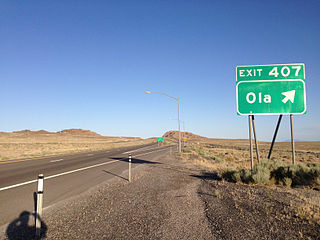
Churchill County is a county in the western U.S. state of Nevada. As of the 2010 census, the population was 24,877. Its county seat is Fallon. Named for Mexican–American War hero brevet Brigadier General Sylvester Churchill, the county was formed in 1861. Churchill County comprises the Fallon, NV Micropolitan Statistical Area. It is in northwestern Nevada. Churchill County is noteworthy in that it owns and operates the local telephone carrier, Churchill County Communications.

The Black Rock Desert is a semi-arid region of lava beds and playa, or alkali flats, situated in the Black Rock Desert–High Rock Canyon Emigrant Trails National Conservation Area, a silt playa 100 miles (160 km) north of Reno, Nevada that encompasses more than 300,000 acres (120,000 ha) of land and contains more than 120 miles (200 km) of historic trails. It is in the northern Nevada section of the Great Basin with a lakebed that is a dry remnant of Pleistocene Lake Lahontan.

The Humboldt River is an extensive river drainage system located in north-central Nevada. It extends in a general east-to-west direction from its headwaters in the Jarbidge, Independence, and Ruby Mountains in Elko County, to its terminus in the Humboldt Sink, approximately 225 direct miles away in northwest Churchill County. Most estimates put the Humboldt River at 300 miles (480 km) to miles 330 miles (530 km) long however, due to the extensive meandering nature of the river, its length may be more closely estimated at 380 miles (612 km). It is located within the Great Basin Watershed and is the third longest river in the watershed behind the Bear River at 355 miles (570 km) and the Sevier River at 325 miles (523 km). The Humboldt River Basin is the largest sub-basin of the Great Basin encompassing an area of 16,840 square miles (43,615 km2). It is the only major river system wholly contained within the state of Nevada.

The Carson River is a northwestern Nevada river that empties into the Carson Sink, an endorheic basin. The main stem of the river is 131 miles (211 km) long although the addition of the East Fork makes the total length 205 miles (330 km), traversing five counties: Alpine County in California and Douglas, Storey, Lyon, and Churchill Counties in Nevada, as well as the Consolidated Municipality of Carson City, Nevada. The river is named for Kit Carson, who guided John C. Frémont's expedition westward up the Carson Valley and across Carson Pass in winter, 1844. The river made the National Priorities List (NPL) on October 30, 1990 as the Carson River Mercury Superfund site (CRMS) due to investigations that showed trace amounts of mercury in the wildlife and watershed sediments.

The Pah Rah Range is a mountain range located in western Nevada in Washoe County just to the northeast of Reno. It is a hook shaped range with the main eastern portion oriented northwest-southeast, approximately 20 miles (32 km) long. The northwest flowing Cottonwood Creek in Warm Springs Valley is bounded on three sides by the range. To the south and east the Truckee River forms the boundary and Pyramid Lake is at the northeast. Spanish Springs Valley north of Reno forms the southwest margin. To the north the narrow Mullen Pass separates the Pah Rah Range from the Virginia Mountains.
New Washoe City is an unincorporated community located in Washoe County, Nevada, United States. It is located in the Washoe Valley in southern Washoe County between Reno and Carson City, on the east side of Washoe Lake. It is part of the Reno–Sparks Metropolitan Statistical Area. As of the 1990 census, New Washoe City had a population of 2,875. The area was not listed as a census-designated place (CDP) at the 2000 census but was listed as "Washoe Valley, Nevada", for the 2010 census, at which time it had a population of 3,019.

Old Washoe City is a ghost town in Washoe County, Nevada, in the United States. Nearby there is a new community called New Washoe City.

Washoe Lake is a lake located near Carson City in the Washoe Valley of Washoe County, Nevada. It is a very shallow lake with a surface area that can vary greatly from year to year. Washoe Lake State Park sits on the lake's southeastern shore.
Stone House is a ghost town in Humboldt County, Nevada, United States.
Pleasant Valley is a very small, unincorporated community in Washoe County, Nevada, United States. The ZIP Code for Pleasant Valley is 89521. The community is part of the Reno–Sparks Metropolitan Statistical Area and Interstate 580, U.S. Route 395 and U.S. Route 395 Alternate run through it and act as a divider between the eastern and western halves of the valley.
Crystal is a former unincorporated community in Clark County, Nevada, United States. It lies along the Union Pacific Railroad and had a population of 10 in 1941. It is now the site of a highway rest stop.

Shafter is a ghost town in Elko County, Nevada, United States.
Clark is an unincorporated community in northern Storey County and southern Washoe County, about 17 miles (27 km) east of Reno and Sparks. Clark can be accessed from the north via Interstate 80 on the USA Parkway exit, and from the west via roads from nearby Lockwood.
Pyramid is an unincorporated community in Washoe County, Nevada, United States. At one time, it was a station on the Fernley and Lassen Railway located between Bristol and Big Canyon. There was a post office at this location from March 1904 until November 1959.

Ophir Creek is a 7.7-mile (12.4 km) eastward-flowing stream originating in Tahoe Meadows just south of Tamarack Peak and southeast of Mount Rose Summit, a pass on Nevada State Highway 431. Ophir Creek flows to Washoe Lake in Washoe County in western Nevada, shortly after passing under U.S. Route 395.

Moor is a ghost town in Ceder Pass in Elko County, Nevada, United States. It is located along Interstate 80 between Wells and West Wendover.

Ola is a ghost town and railroad siding in eastern Elko County, Nevada, United States.
Tulasco is an extinct town in Elko County, in the U.S. state of Nevada.
Barro is a ghost town and railroad siding in Tooele County, Utah, United States. It is located along the Central Corridor Union Pacific Railroad rail line and the Wendover Cut-off and south of Interstate 80 in the Great Salt Lake Desert.
Borax is a ghost town and railroad siding in Clark County, Nevada, United States located along the Union Pacific Railroad east of Interstate 15.













